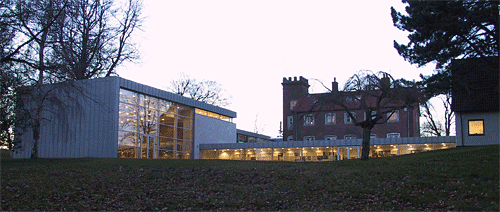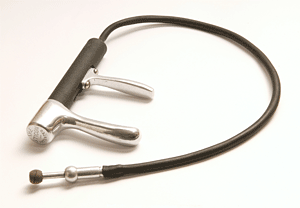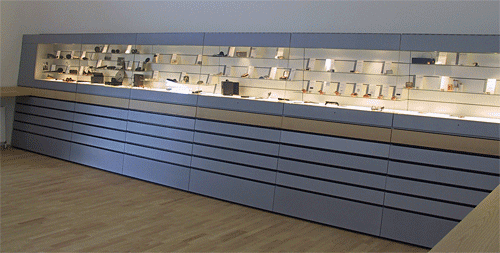Interview with Claus Nielsen Oticon Research Center - Eriksholm, Denmark
Topic: Oticon Museum, History, Research and Eriksholm
Beck: Hi Claus, thanks for your time today.
Nielsen: Good Morning Doug. Nice to be with you, too.
Beck: Claus, how long have you been with Oticon?
Nielsen: I've been here for 17 years.
Beck: I'd like to speak with you this morning about some of your responsibilities, Oticon, and the Eriksholm research facility in Denmark. I believe you've been responsible for the Oticon Museum and the historical archives at the Eriksholm research facility?
Nielsen: Yes, well a few of us have had that shared responsibility, but I have been in charge for a little more than 10 years.
Beck: Would you please give us an overview of Eriksholm?

Nielsen: Oticon acquired the Eriksholm facility in 1976 and opened it as a research facility in 1977. The building itself was originally constructed in 1862. As you can see, we've modernized a few of the attributes here and there! We're located about 25 miles north of Copenhagen. The initial goal was to learn everything there was to know about hearing aids, hearing loss and people with hearing loss and foster ideas for the development of new products!
Beck: That's a rather tall order! So the original goal wasn't really just a technology-based "think tank," but rather, to figure out how hearing loss impacts people, and to study human hearing mechanisms too?
Nielsen: Yes. We're not quite finished just yet! But we have made significant progress. In addition to the scientific endeavors that occur here, we have a clinical setting where we gather data on our test subjects too.
Beck: And I believe that's another of the hats you wear as the manager of the "test panel" activities?
Nielsen: Yes, that's right. The test panel is our most important tool. We spend lots of time collecting data and speaking with the test subjects to be sure we understand the problems they address based on their hearing loss. Additionally, as needed, I also adjust or fit new instruments to make sure they are getting all they can from their hearing.
Beck: What are the most important tools you use in your work?
Nielsen: That's an interesting question. Probably the diagnostic tools here are the same as you'll find in many places, but what I get the most information from are the questionnaires and especially the one-on-one interviews with the people wearing hearing aids. It's really all about the hearing impaired people and their expectations, needs and social interaction in daily life.
Beck: And not to get off subject too much, but this is the hundredth year anniversary of Oticon, and that's an amazing accomplishment, essentially a tribute to it's people. Can you give me a brief "greatest hits" timeline?
Nielsen: Well, I'll have to leave out quite a bit...but OK...In 1904, Hans Jorgen Frederik Demant started a hearing aid company in Denmark. In 1908 Hans became the Acousticon dealer for all of Scandinavia. In 1910 Hans died, and his son, William Demant, took over the company. In 1943 the word "Oticon" became part of the company name. In 1946 the company produced Denmark's first hearing aid, the Oticon TA. In 1965, Oticon opened in the USA. In 1977, Eriksholm opened and in 1979 William Demant died. In 1991, MultiFocus was launched, in 1993, we received the ISO 9001 certification from the Danish Standardization Board, in 1996, DigiFocus was launched, in 2001 Adapto was launched, in 2002, Eriksholm celebrated it's 25th Jubilee, in 2003 William Demant Holding (formerly Oticon Holding) was named European Company of the Year, and in 2004, we introduced Oticon Syncro, and celebrated our 100th year Jubilee.
Beck: That is simply amazing!
Nielsen: Thank you.
Beck: Excellent. If you don't mind...Can you please tell me a little about the Eriksholm Collection? In particular, when I visited the facility, I recall seeing a little tool actually called an "Oticon."
Nielsen: Yeah, that device is a little odd. The device was actually an "ear massager" and it looks a little like a dental drill bit! I don't have any idea how many were sold or why, but that was the original Oticon. As far as I know only two of these instruments still excist one at CID in St. Louis and the one here at Eiksholm.

The collection was started in 1986. We now have some 200 assorted hearing aids from all over the world which are on display, and then at least another 500 or so are in storage. The library has some 1500 textbooks and more than 5500 magazines and periodicals. As you can imagine, This is a great facility for Eriksholm research staff.
Beck: What is the oldest hearing aid in the collection?
Nielsen: We have an 1908 Acousticon model RD hearing aid -96 years old, so that's the oldest. That's a fairly large hearing aid, and the microphone is the largest part,

Beck: What does the future hold for Eriksholm?
Nielsen: We use the facility for the purposes we've already discussed, but too, we use it for teaching and for conferences. We have a wonderful state-of-the-art auditorium which opened in 2001, and we have professional conferences occur here often, many in collaboration with other institutions. I believe Eriksholm will continue to focus on designing research tools, developing hearing aids for research use, creating software and test equipment, and of course more work is yet to be done in order to help probe the minds and listening sensations of people with hearing loss. So we'll continue to push forward the frontiers with new ideas aided by innovative technology, with a careful eye towards how the equipment and technology interact with humans!
Beck: Thanks so much for your time. It really has been delightful speaking with you.
Nielsen: Thank you too, Doug. It's been a lot of fun for me too.
For more information on OTICON, please click here.
Nielsen: Good Morning Doug. Nice to be with you, too.
Beck: Claus, how long have you been with Oticon?
Nielsen: I've been here for 17 years.
Beck: I'd like to speak with you this morning about some of your responsibilities, Oticon, and the Eriksholm research facility in Denmark. I believe you've been responsible for the Oticon Museum and the historical archives at the Eriksholm research facility?
Nielsen: Yes, well a few of us have had that shared responsibility, but I have been in charge for a little more than 10 years.
Beck: Would you please give us an overview of Eriksholm?

Nielsen: Oticon acquired the Eriksholm facility in 1976 and opened it as a research facility in 1977. The building itself was originally constructed in 1862. As you can see, we've modernized a few of the attributes here and there! We're located about 25 miles north of Copenhagen. The initial goal was to learn everything there was to know about hearing aids, hearing loss and people with hearing loss and foster ideas for the development of new products!
Beck: That's a rather tall order! So the original goal wasn't really just a technology-based "think tank," but rather, to figure out how hearing loss impacts people, and to study human hearing mechanisms too?
Nielsen: Yes. We're not quite finished just yet! But we have made significant progress. In addition to the scientific endeavors that occur here, we have a clinical setting where we gather data on our test subjects too.
Beck: And I believe that's another of the hats you wear as the manager of the "test panel" activities?
Nielsen: Yes, that's right. The test panel is our most important tool. We spend lots of time collecting data and speaking with the test subjects to be sure we understand the problems they address based on their hearing loss. Additionally, as needed, I also adjust or fit new instruments to make sure they are getting all they can from their hearing.
Beck: What are the most important tools you use in your work?
Nielsen: That's an interesting question. Probably the diagnostic tools here are the same as you'll find in many places, but what I get the most information from are the questionnaires and especially the one-on-one interviews with the people wearing hearing aids. It's really all about the hearing impaired people and their expectations, needs and social interaction in daily life.
Beck: And not to get off subject too much, but this is the hundredth year anniversary of Oticon, and that's an amazing accomplishment, essentially a tribute to it's people. Can you give me a brief "greatest hits" timeline?
Nielsen: Well, I'll have to leave out quite a bit...but OK...In 1904, Hans Jorgen Frederik Demant started a hearing aid company in Denmark. In 1908 Hans became the Acousticon dealer for all of Scandinavia. In 1910 Hans died, and his son, William Demant, took over the company. In 1943 the word "Oticon" became part of the company name. In 1946 the company produced Denmark's first hearing aid, the Oticon TA. In 1965, Oticon opened in the USA. In 1977, Eriksholm opened and in 1979 William Demant died. In 1991, MultiFocus was launched, in 1993, we received the ISO 9001 certification from the Danish Standardization Board, in 1996, DigiFocus was launched, in 2001 Adapto was launched, in 2002, Eriksholm celebrated it's 25th Jubilee, in 2003 William Demant Holding (formerly Oticon Holding) was named European Company of the Year, and in 2004, we introduced Oticon Syncro, and celebrated our 100th year Jubilee.
Beck: That is simply amazing!
Nielsen: Thank you.
Beck: Excellent. If you don't mind...Can you please tell me a little about the Eriksholm Collection? In particular, when I visited the facility, I recall seeing a little tool actually called an "Oticon."
Nielsen: Yeah, that device is a little odd. The device was actually an "ear massager" and it looks a little like a dental drill bit! I don't have any idea how many were sold or why, but that was the original Oticon. As far as I know only two of these instruments still excist one at CID in St. Louis and the one here at Eiksholm.

The collection was started in 1986. We now have some 200 assorted hearing aids from all over the world which are on display, and then at least another 500 or so are in storage. The library has some 1500 textbooks and more than 5500 magazines and periodicals. As you can imagine, This is a great facility for Eriksholm research staff.
Beck: What is the oldest hearing aid in the collection?
Nielsen: We have an 1908 Acousticon model RD hearing aid -96 years old, so that's the oldest. That's a fairly large hearing aid, and the microphone is the largest part,

Beck: What does the future hold for Eriksholm?
Nielsen: We use the facility for the purposes we've already discussed, but too, we use it for teaching and for conferences. We have a wonderful state-of-the-art auditorium which opened in 2001, and we have professional conferences occur here often, many in collaboration with other institutions. I believe Eriksholm will continue to focus on designing research tools, developing hearing aids for research use, creating software and test equipment, and of course more work is yet to be done in order to help probe the minds and listening sensations of people with hearing loss. So we'll continue to push forward the frontiers with new ideas aided by innovative technology, with a careful eye towards how the equipment and technology interact with humans!
Beck: Thanks so much for your time. It really has been delightful speaking with you.
Nielsen: Thank you too, Doug. It's been a lot of fun for me too.
For more information on OTICON, please click here.

